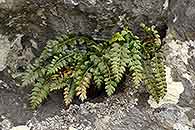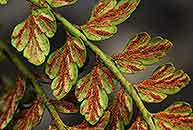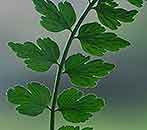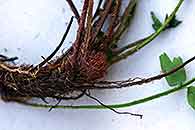Asplenium stuhlmannii Hieron.
Synonyms |
Asplenium stuhlmannii Hieron var. laciniata Hieron |
|---|---|
Common name |
|
Description |
Rhizome shortly creeping or erect, up to 5 mm diameter; rhizome scales 2.5-8 x 0.3-0.5 mm, shiny pale to dark brown, lanceolate to narrow triangular in outline, margins entire or with outgrowths, apex tapering to a point. Fronds not proliferous, tufted, erect to arching. Stipe up to 14(-28) cm, dark brown, set with scales similar to those of rhizome, subglabrous when mature. Lamina 6-38 cm × 1.6-8.8 cm, narrowly oblanceolate in outline, pinnate to deeply 2-pinnatifid, lower pinnae slightly reduced. Pinnae 8-15 pairs, up to 3(-4.5) x 1.6(-2.5) cm, glabrous, leathery, ovate in outline, venation flabellate, incised more than 1/2 way to the costa into 3-5 obtuse toothed lobes with the basal acroscopic lobe prominent and almost free. Rhachis dark brown, at first densely set with scales similar to stipe, becoming glabrous with age. Sori linear closely packed, (1-)3-10 mm long, typically covering the whole undersurface of the pinnae upon dehiscence; indusium linear, membranous, 0.4-0.5 mm wide, entire to slightly erose. |
Notes | Differs from similar species by thicker texture, narrower lamina and shortly ovate deeply incised pinnae. |
Derivation | stuhlmannii: named after Franz Ernst Stuhlmann, one time Acting Governor of Tanganyika and an avid collector of plants. |
Habitat | Moist forest, miombo woodland, full sun or light shade in rock crevices and sheetrock mats on granite outcrops. |
Distribution worldwide | See African distribution. |
Distribution in Africa |
Burundi, Equatorial Guinea (incl. Bioko), Guinea, Ivory Coast, Kenya, Liberia, Mozambique, Nigeria, Rwanda, Sierra Leone, Sudan and South Sudan, Tanzania , Uganda, Zambia, Zimbabwe. |
Growth form |
Epiphytic, lithophytic. |
Literature |
|





